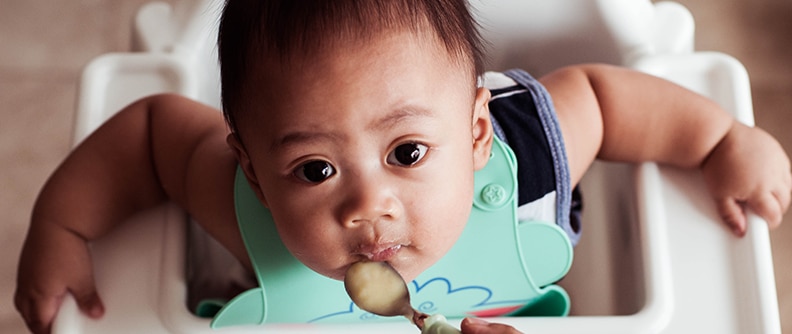Your baby will start to show interest in eating solid foods between 4 and 7 months. You’ll know that your baby is ready when they can sit without support, have good head control, swallow without gagging, and show an interest in what you’re eating. Your baby may even open their mouth to “get a bite” while you’re having something to eat.
When you first introduce solid foods, it’s a good idea to follow a routine. You can begin by feeding your baby solids once a day. Work up to 2 to 3 times every day. Your baby may also enjoy a small snack or two between meals.
You can still breastfeed even if you’ve started your infant on solids. Clinicians often recommend breastfeeding until your baby is at least 12 months old. This ensures your baby gets all the nutrients they need for healthy growth.
Foods to offer babies
Babies should only have soft foods at first. Try offering small bites using a soft-tipped baby spoon.
Good foods to offer include:
- Infant oatmeal, which can be mixed with formula or breastmilk.
- Mashed avocado, banana, or beans.
- Plain, whole-milk yogurt.
- Pureed meat, sweet potato, or other vegetables.
Don’t overfeed your baby. Let them decide when and how much to eat.
A note about food allergies
Many new parents worry about food allergies. It’s true that some foods, like cow’s milk, eggs, wheat, nuts, soy, and seafood, can cause allergic reactions. But recent research suggests that giving your baby small amount of these foods early on can help prevent allergies.
For example, you can mix a tiny amount of peanut butter or peanut flour into your baby’s oatmeal or yogurt. This early exposure to peanut products can help prevent an allergy from developing. Babies shouldn’t eat anything they have to chew on, so don’t give your baby whole peanuts.
Introduce your baby to one new food at a time. Give them a small bite, then wait for 10 minutes. This allows you to see if they have a reaction. If there’s no reaction, give them the rest.
Feed this food to your baby 2 to 3 times each week to help prevent food allergies. Wait for 2 to 3 days before introducing another new food. If your baby has a reaction to something, this can help you pinpoint the cause.
Signs of a food allergy include:
- Diarrhea.
- Skin rash.
- Trouble breathing.
- Vomiting.
Let your baby’s clinician know if you have a strong family history of food allergies. If your baby shows signs of reacting to a food, contact your clinician.
What to know about baby-led weaning
Another method of introducing solid foods is called baby-led weaning. In this process, babies should be encouraged to pick up new foods with their own hands. They can eat as much of the new food as they’d like.
Research indicates baby-led weaning allows infants to control what and how much they eat. This may make them less picky eaters. Baby-led weaning gives babies a chance to practice motor and oral skills.
Not all foods are appropriate for baby-led weaning. Food should be firm enough to grip but soft enough to gum. Spears of soft fruit, cooked vegetables, and soft strips of meat can work well. Stay away from hard foods or foods that a baby could easily choke on, such as firm, round foods like berries or grapes, nuts, or hard vegetables like raw carrots.
There is no evidence that baby-led weaning increases the risk of choking on food.
